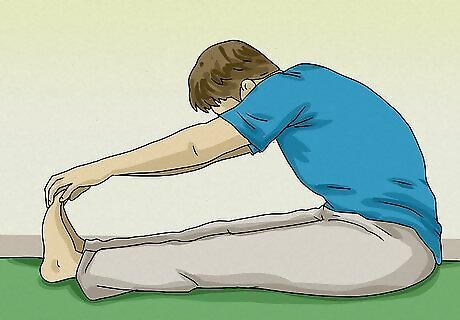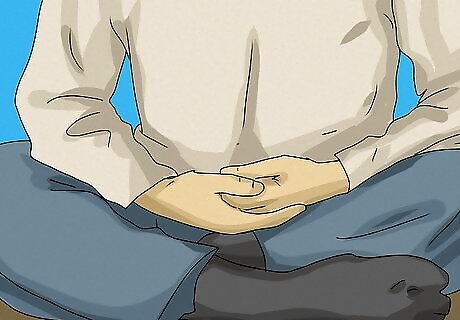
views
Beginning Your Meditation

Prepare yourself and your space for meditation. Turn off your television and your cell phone, and eliminate other external distractions. Use a space in which you feel comfortable and free from the need to complete tasks and other stressors. Set aside designated time to meditate, preferably between twenty minutes and a couple hours, depending on your abilities and preferences. Wear comfortable, loose-fitting clothes that are suitable for your space’s temperature. You’ll want to avoid being distracted by stiff clothing or by being too hot or too cold. Don’t allow birds chirping, cars driving by, and other unavoidable external sounds to interrupt your meditation. Being aware of the world and its interconnections can actually be beneficial to meditation. However, if you live in a location, such as by a subway stop or train track, where noise is dominating your thoughts, you should consider putting on music or a mantra recording, both of which are available on Youtube and other services.

Stretch your body. To eliminate stiffness and tension in your body as you sit still to meditate, you should stretch yourself out before beginning. Take a few minutes before meditating to stretch your legs, hips, back, shoulders, and neck. While sitting, hold your legs out straight in front of you and reach for your toes to stretch your calves and hamstrings. Bend your knees while seated and bring the soles of your feet together to stretch your hips and quadriceps.

Sit in a comfortable position. Typically, one sits in a seated, cross-legged position when they meditate. Do so only if it’s comfortable for you to sit cross-legged for an extended period of time, and hold your back upright, unbowed but not unnaturally straight. However, consider sitting in a chair or with your back braced by a wall or other object if you are unable to sit cross-legged without discomfort. Remember it's important to wear comfortable clothes that allow you to sit still for a while. You will want to avoid distractions from tension or stiffness in your body. Especially if you are just beginning to practice meditation, it is most important to find a distraction-free, comfortable body position. Sit on a yoga mat, a cushion, or on folded blankets or towels for more comfort.

Establish your breathing. Begin your meditation with controlled breathing techniques. Be conscious of your breathing and use each breath you take to focus your intention. Breathe in slowly as you count to four, hold for four, and exhale for four. Let your awareness on your breath help you clear your mind and focus your concentration. As you inhale, consider light flowing through your essence, as life rises through your vertebrae and fills you. Imagine the energy-filled center at the point where your in-breath fuses with your out-breath. As you exhale and your breath is out completely, visualize a universal pause in which your particular self vanishes and focus on your interconnectedness with everything around you.
Visualizing Images of Shiva

Visualize Shiva as the Winner. Begin to concentrate on images of Shiva to guide your meditation. Envision Shiva as the victorious Yogi. Hold your hands in fists near your head. Shake them and think of a goal or intention. Say or think to yourself, "I am a winner. I reach my goal. My goal is," and name your goal. A goal or intention could be to succeed at a particular task or difficulty, like finding the motivation to complete a project, or improving a relationship with a friend or family member. Your goal could be more general, like being more present at work or when interacting with others, or being more honest and direct with yourself.

See the strong Shiva. Envision and become the strong Shiva with your next visualization. While sitting cross-legged, rub your feet on the ground. Visualize yourself high on the peaks of Mount Meru. Say or think to yourself, "I am sitting on the Mount Meru. I maintain equanimity in pain. I'm going with perseverance my way." Mount Meru is a mythical, five-peaked sacred mountain in Hinduism, Jainism, and Buddhism. It is also the name of a Himalayan mountain located in northern India.

Envision the egoless Shiva and become egoless. Make large circles with your hands around your body. Visualize the universe, cosmos, stars, and their interconnectedness. Say or think, "I live in the great system of the cosmos. I take things the way they are."

Meditate on Shiva the Hatha Yogi. Visualize within yourself the Kundalini Serpent. Envision your latent or primal power within your core. Twist your spine, move your toes and imagine the Kundalini uncoiling from your lower spine to your head. Say or think to yourself, "I am a Hatha Yogi. I save myself with my spiritual exercises." The Kundalini is your primal energy or latent power, thought of as a coiled serpent to be awakened. It rises from the base of your spine as it is awakened through meditation, chanting, yoga, and other spiritual practices.

Visualize Shiva the Karma-Yogi. Envision and become Shiva the Good, who works for a happy world. Extend your hand with an upward- and outward-facing palm. Focus on your good intentions, and send all beings light. Say out loud or think, "I send light” and say a specific name or intention, or say to all things. Say, “May all beings be happy. May the world be happy."
Chanting Mantras

Understand the power of sound. When chanting a mantra or uttering the name of a deity as a mantra, you are in effect merging with that deity’s being. When you utter a divine name, you experience the divine within yourself. You should treat any mantra with respect, and speak it with full understanding of its meaning.

Meditate on Shiva the Master Yogi. Hold your palms together at your chest in front of your heart chakra. Visualize the sky above you. Say, "Om all enlightened Masters. Om inner wisdom. Please guide and help on my way." ”Om” or "Aum" is the sacred sound associated with the vibration of the cosmos. It is that which sustains everything that is. In order to enunciate the "Ah" sound, first open your mouth wide and imagine the universe's creative moment coursing through your body from deep within you, as if the Om were speaking you, rather than you speaking the sound. Then, begin to purse the lips and stretch the sound into its latter component, the "Mmm," which also has a slight "ng" aspect to its pronunciation. Touch the roof of your mouth with your tongue as you speak the final syllables to symbolize the closing of the process of creation.

Chant the mantra, “Om Namah Shivaya.” Concentrating on a picture or a statue of Shiva is helpful while chanting this mantra. Move one hand outward and take the energy from Shiva. Say out loud or think to yourself the mantra, “Om Namah Shivaya,” a Sanskrit mantra that means “I bow to Shiva” or “I connect myself with Shiva.” Use a mantra recording to help guide your chanting, or play it prior to meditating to assist you with proper pronunciation. Say and repeat “Shivo Ham,” or “I am Shiva,” and feel how the energy of Shiva flows with the mantra through you.

Conclude your meditation. Put your hands in your lap and move your toes around. Say out loud or think to yourself the mantra, “Om Shanti. Om Peace,” repeating the mantra for at least a minute. Utter it from your belly and feel its vibration emanating from within you. Stop chanting and just sit for some time with your mind clear of thoughts. Keeping your spine is straight and your belly relaxed, just sit without thinking for some time. Breathe slowly, but without awareness of your breaths, and relax. As you allow thoughts to return, envision yourself as Shiva the Dancer. Think positively as you complete your meditation, envisioning light and blessings to continue with you.


















Comments
0 comment